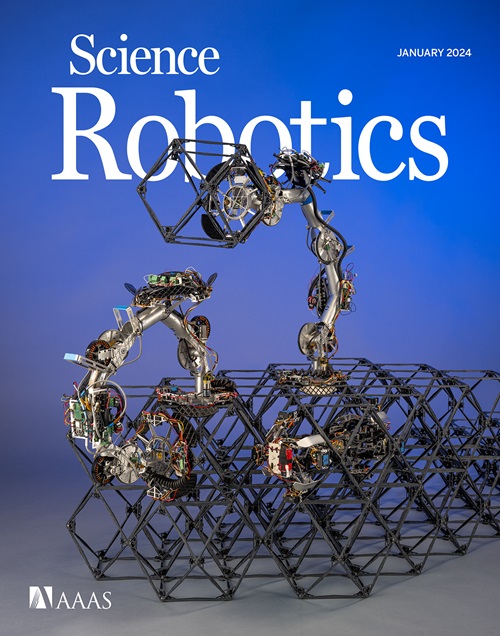基于注意的映射编码学习广义腿部运动
IF 27.5
1区 计算机科学
Q1 ROBOTICS
引用次数: 0
摘要
腿式机器人的动态运动是扩展移动机器人操作范围的一个关键而又具有挑战性的课题。当可能的立足点稀疏时,它需要精确的规划,对不确定性和干扰的鲁棒性,以及跨不同地形的通用性。尽管传统的基于模型的控制器擅长在复杂地形上进行规划,但它们难以应对现实世界的不确定性。基于学习的控制器对这种不确定性具有鲁棒性,但在具有稀疏可步进区域的地形上往往缺乏精度。混合方法通过结合两种方法来增强稀疏地形上的鲁棒性,但计算量大,并且受到基于模型的规划器固有局限性的约束。为了在保持基于学习的控制器的鲁棒性的同时实现在不同地形上的广义腿部运动,本文提出了一种基于机器人本体感觉的基于注意力的地图编码,并使用强化学习将其作为控制器的一部分进行训练。我们表明,当机器人动态导航各种具有挑战性的地形时,网络学会关注可行走的区域,为未来的立足点做好准备。我们合成了对不确定性表现出鲁棒性的行为,同时使稀疏地形的精确和敏捷遍历成为可能。此外,我们的方法提供了一种解释神经网络的地形感知的方法。我们已经为一个12自由度的四足机器人和一个23自由度的人形机器人训练了两个控制器,并在现实世界中测试了各种具有挑战性的室内和室外场景,包括训练中看不到的场景。本文章由计算机程序翻译,如有差异,请以英文原文为准。
Attention-based map encoding for learning generalized legged locomotion
Dynamic locomotion of legged robots is a critical yet challenging topic in expanding the operational range of mobile robots. It requires precise planning when possible footholds are sparse, robustness against uncertainties and disturbances, and generalizability across diverse terrains. Although traditional model-based controllers excel at planning on complex terrains, they struggle with real-world uncertainties. Learning-based controllers offer robustness to such uncertainties but often lack precision on terrains with sparse steppable areas. Hybrid methods achieve enhanced robustness on sparse terrains by combining both methods but are computationally demanding and constrained by the inherent limitations of model-based planners. To achieve generalized legged locomotion on diverse terrains while preserving the robustness of learning-based controllers, this paper proposes an attention-based map encoding conditioned on robot proprioception, which is trained as part of the controller using reinforcement learning. We show that the network learns to focus on steppable areas for future footholds when the robot dynamically navigates diverse and challenging terrains. We synthesized behaviors that exhibited robustness against uncertainties while enabling precise and agile traversal of sparse terrains. In addition, our method offers a way to interpret the topographical perception of a neural network. We have trained two controllers for a 12-degrees-of-freedom quadrupedal robot and a 23-degrees-of-freedom humanoid robot and tested the resulting controllers in the real world under various challenging indoor and outdoor scenarios, including ones unseen during training.
求助全文
通过发布文献求助,成功后即可免费获取论文全文。
去求助
来源期刊

Science Robotics
Mathematics-Control and Optimization
CiteScore
30.60
自引率
2.80%
发文量
83
期刊介绍:
Science Robotics publishes original, peer-reviewed, science- or engineering-based research articles that advance the field of robotics. The journal also features editor-commissioned Reviews. An international team of academic editors holds Science Robotics articles to the same high-quality standard that is the hallmark of the Science family of journals.
Sub-topics include: actuators, advanced materials, artificial Intelligence, autonomous vehicles, bio-inspired design, exoskeletons, fabrication, field robotics, human-robot interaction, humanoids, industrial robotics, kinematics, machine learning, material science, medical technology, motion planning and control, micro- and nano-robotics, multi-robot control, sensors, service robotics, social and ethical issues, soft robotics, and space, planetary and undersea exploration.
 求助内容:
求助内容: 应助结果提醒方式:
应助结果提醒方式:


